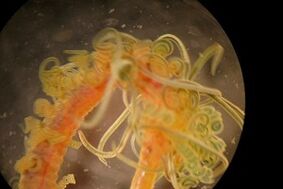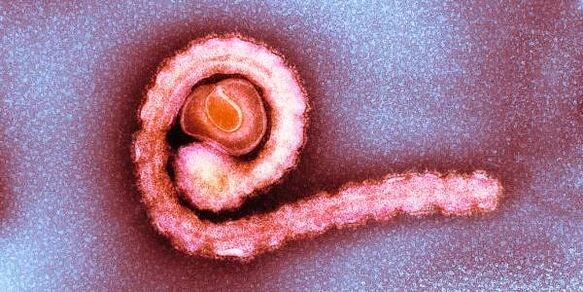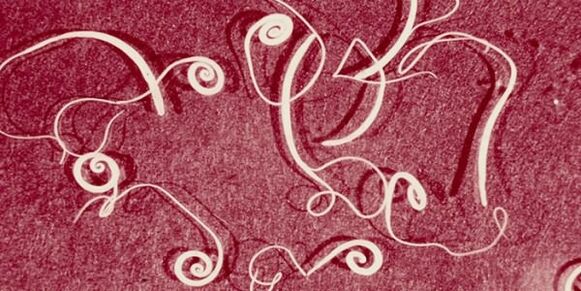
The history of helminthology goes back thousands of years.
The first documents describing parasites in the human body, classified as roundworms according to modern classification, date from the 6th century BC.
The term "helminth", which is ubiquitous today, was introduced by Hippocrates.
Since then, information about parasites has been accumulating.
Now there are more than 100 thousand species.
All these varieties of helminths are classified as lower worms of the scolecida type (lat. Scolecida).
They are divided into four categories:
- flatworms are a class of cestodes (tapeworms) and trematoders (flukes);
- roundworms, which include one broad class of nematodes;
- worm worms;
- annelids
The human body is a parasite of helminths of the first two types (more than 250 species in total).Helminths spend the main stages of their life cycle in the bodies of people or animals, called hosts.
All parasites are divided into two large groups:
- underground chamber,Their development begins in the external environment and ends in the tissues of the "host";
- biohelminths,Their life activity occurs only in living organisms, and during the process of development, such worms can change several "hosts".
There is also a group of so-called infectious helminths.These parasites in the human body can be transmitted through close contact with an infected person;this species includes pinworms and dwarf tapeworms.
The most common nematode infections are:

- ascariasis, caused by the human roundworm;
- toxocariasis, which occurs when roundworms enter the intestines of animals;
- trichocephaosis, develops due to infection with whipworms;
- enterobiasis caused by pinworms;
- hookworm, their appearance is caused by hookworm and necator parasites;
- strongyloidiasis, the cause of which is acne in the intestines;
- trichostrongylidosis caused by the parasite of the same name;
- trichinosis caused by one of four species of trichinosis;
- filariasis, the cause of which is filariae, also called threads.
Among cestodiases, the following diseases are distinguished:
- diphyllobothriasis, causative agent - broad tapeworm;
- teniarinhoz caused by bovine tapeworm;
- taeniasis or cystitis caused by swine tapeworm;
- hymenolepidosis, causative agent - dwarf tapeworm;
- doublets caused by canine tapeworm parasites;
- echinococcosis, the cause of the disease is echinococcus or echinococcal tapeworm;
- alveococci, causative agent - alveococci.
Of trematodes, the following helminthiasis are often diagnosed:

- fascioliasis, causative agent - Fasciola vulgaris;
- opisthorchiasis, the cause of which is the parasitic damage of cat fleas;
- clonorchiasis caused by Chinese infection;
- metagonimiasis, causative agent - metagonimus;
- schistosomiasis (genital, intestinal, Japanese), caused by the parasite of the same name.
A special group includes the so-called protozoan diseases caused by the presence of single-celled protozoa: amoebas, malarial plasmodium, trypanosomes, lamblia, toxoplasma, trichomonas.
The average person has no idea how many parasites they have to deal with every day.These microbes are everywhere: in the soil, sandboxes, railings, common household items, toys, towels in swimming pools, baths and saunas, ponds, on fur, paws and saliva of pets.However, the transformation of larvae and eggs into mature individuals does not always occur.In the vast majority of cases, in the body of a healthy person, parasites die and are eliminated from the intestines.
However, in the tissues of children, people with immunodeficiency, diseases of the digestive tract and endocrine system, further transformation of worm larvae into adult males and females occurs.
Their life activities include:
- metabolic disorders;
- vitamin deficiency;
- lack of minerals and proteins;
- the formation of an allergic response, which is fraught with the development of autoimmune processes;
- negative effects of toxic waste products from helminths.
In addition, almost all parasites mechanically damage various tissues at all stages of their life cycle.The larvae of many worms (strongyloides, schistosomes and others) when they enter the body violate the integrity of the skin and mucous membrane.The dwarf tapeworm causes a change in the structure of the epithelium of the small intestine down to the deepest layers.With echinococcosis and alveococcosis, as the larvae grow, mechanical compression occurs of the surrounding tissues, usually the liver, resulting in jaundice.

The digestive tract is actively washed with blood.Through its walls, worms enter the main blood vessels and from there enter almost any organ.The location of the main foci in the development of parasites determines the main symptoms of the disease.The introduction of helminths affects in one way or another the functioning of all organs and systems: immune system, nervous system, blood circulation, digestive system.
The severity of the lesion and clinical symptoms, the method of treatment depends on the type of parasite.Relatively "harmless" pinworms and roundworms cause gastrointestinal disturbances in most cases.And entry into the body of protozoa (for example, amoeba) can cause meningitis, pericardial disease and death.Parasites settle in the skin, organs of vision, brain and muscle tissue.
To remove some helminths, you can use folk remedies (pumpkin seeds, cleansing enemas with garlic and soda, infusion with celandine, ginger root, tansy and other medicinal plants).But in case of severe and massive infections, herbs, homeopathic drops and herbal supplements cannot be used.To eliminate worms, long-term drug therapy is necessary and help to restore the basic function of the digestive tract.
The development of helminthiasis can only be prevented by following certain preventive measures.
However, to prevent infection, it is necessary to know the main ways that parasites appear in the human body:

- Oral through hands, unwashed food, wool, feathers of farm animals and birds, where parasite eggs and larvae are present along with soil.This way you can get infected with ascariasis, enterobiasis and giardiasis.
- Xenotrophic when consumed as food from thermally unprocessed meat, milk, fish and seafood.This mode of transmission is typical for trichinosis and taeniasis.
- Contact, for example, through the pores of the skin, schistosomes enter the body (they live in hot climates).
- Transmitted through the blood by insect bites (for example, filariasis).
- Transmission from mother to fetus, this is how toxoplasmosis is transmitted.
Given the reality of modern family medicine, they try to postpone a visit to the doctor until the last minute, especially since you can buy drugs to get rid of helminthiasis without a prescription in every pharmacy.But not everything is as simple as it seems at first glance.Antiparasitic methods are not the same in their therapeutic efficacy;in addition, different types of worms "need" an individual choice of dosage and duration of treatment.
Therefore, if you suspect that there are parasites in the human body, you need to contact a specialist.The algorithm of his operation is as follows:
- examination of the patient and collection of anemia (for example, a recent return from foreign countries requires special research to identify the pest);
- order of a general blood test, stool, joint plan;
- blood test for the presence of specific antibodies, this analysis will accurately determine the causative agent of the disease;
- evaluation of the condition of internal organs, the presence of abscesses, ulcers and necrotic areas caused by parasites;
- detect possible co-morbidities that may be contraindications to the prescription of certain drugs.
This is important!
Self-treatment of helminthic infections is contraindicated during pregnancy and breastfeeding.
Signs of parasites in the body by location
Tissue damage caused by helminths is accompanied by numerous pinpoint hemorrhages.This causes anemia, weakness, fatigue and reduced performance.Due to disruption of metabolic processes and absorption of vitamins and minerals, the condition of the skin, nails and hair worsens.A person loses weight quickly and suffers from frequent viral and infectious diseases.

Also, the vital activity of most pathogenic microorganisms takes place during the release of toxins.The immune system reacts to their appearance accordingly, so if there are parasites in the human body, the symptoms of an allergic reaction will certainly be present.There are also clinical symptoms of general intoxication, which manifest themselves in malaise, irritability, insomnia, neurological disorders and deterioration of well-being.
The development of parasite invasion in the tissues of the human heart occurs against the background of serious disturbances in the functioning of the heart muscle.
Patients complain of:
- shortness of breath;
- change in heart rate;
- feeling of lack of air;
- discomfort and heaviness in the chest.
Adding to the inflammatory process can cause pericarditis or myocarditis.These diseases are accompanied by increased body temperature and severe pain in the heart area.
Epidermal helminthiasis are relatively rare.As a rule, they develop against the background of damage to the intestines and other internal organs.
Signs of parasites in the body when some worms invade the skin can look like this:

- sores in contact with feces;
- the appearance of an itchy rash;
- swelling and redness, sometimes during the transfer of helminths;
- the formation of swellings that resemble wen in appearance;
- the appearance of purulent acne.
Symptoms of parasites entering the eye depend on several factors.If the helminth "lives" under the skin of the eyelid, its movements can be felt or even seen.However, as worms move deeper into the optic nerve, there is a risk of strabismus, severe vision loss, and limited vision.Without proper treatment, the development of helminthiasis in the eye can lead to irreversible blindness.
The digestive tract is the habitat of the vast majority of helminths.Therefore, if parasites appear in the human body, symptoms appear primarily from the digestive system.
The patient usually complains of:
- varying degrees of pain and discomfort in the abdomen;
- diarrhea, which can be replaced by constipation, this is especially typical in the early stages of infection;
- mixing of mucus and blood in the stool;
- painful spasms occur simultaneously with the urge to defecate;
- decreased or lack of appetite;
- flatulence, bloating.
As a result of digestive gland dysfunction, one constantly feels heaviness in the stomach.In some cases, roundworms can cause intestinal obstruction.
The entry of worms into the hematopoietic system is accompanied by disturbances throughout the body.Moreover, such an invasion sometimes does not manifest itself in the form of external symptoms.However, due to the destruction of red blood cells and other formed elements, frequent headaches, dizziness, drowsiness occur, despite compliance with the daily routine, constant weakness and intolerance to physical exertion.
Also signs of parasites in the body in the circulatory system include enlarged lymph nodes and worsening of chronic diseases.The size of the liver and spleen changes upwards and the body temperature often rises.
Doctors emphasize that the discovery of a foreign "creature" in the body should not be a reason for panic.Modern drugs make it possible to quickly and without side effects cleanse all organs of helminths and completely restore their functionality.
Human parasites: methods of treatment and prevention
Relatively recently, some private clinics announced that a new safe method has been created to fight worms - bioresonance therapy.The principle of this treatment is based on the laws of physics.According to the theories of the developers of this method, each cell of our body is not motionless in one place, but is in constant vibration and emits electromagnetic waves.Their length is individual for each internal organ.
Human parasites are no exception, but the resonance of their movements differs from the tissues of our bodies.During bioresonance therapy, metal electrodes are placed on certain biologically active points.They send waves of a certain length, which do not affect the functioning of their own cells, but destroy the body of parasites.

The advantages of bioresonance therapy include safety and painlessness.However, the clinical effectiveness of this treatment method has not been proven and the treatment equipment does not have the appropriate certification.But exposure to electromagnetic waves will not cause any harm and will not cause complications.
There are actually not that many drugs used to get rid of helminths and protozoa.Doses of drugs, regimen and duration of their use are selected by the doctor depending on the age of the patient, the severity of the invasion and the presence of concomitant pathologies.
For a relatively mild helminthic infection, it is recommended to use traditional medicinal recipes.These products are easy to prepare at home and the components are sold at any pharmacy.
To expel helminths from the intestines, doctors recommend:
- Consume as much onion, garlic, ginger and pomegranate as possible.
- Buy regular cloves, which are used in cooking.It is ground in a coffee grinder and taken according to the following system: on the first day 0.5 g, on the second - 1 g, and from the third to the ninth - 1.5 g in the morning on an empty stomach.
- Pour a tablespoon of ground and dried nettle roots into a glass of boiling water and simmer in a water bath for 15 minutes.Let it cool completely and take 3 tbsp.l.three times a day before meals.
- Mix aloe and onion juice in equal proportions, add honey and take a tablespoon 3 times a day for several weeks.
- Mix 10 tbsp.l.flaxseed and 1 tbsp.l.cloves, grind and take at the rate of 2.5 g of powder per 1 kg of body weight.
- Mix grated coconut flour and coconut milk.Use this mixture 1 tsp.three times a day on an empty stomach.
Almost the only method of preventing human parasites from appearing in the intestines and other tissues is strict adherence to the rules of hygiene, which everyone knows from childhood.This is washing your hands before eating, after going to the toilet and after a walk.Careful heat treatment of drinking water, milk, meat, fish and cleaning of fresh vegetables and fruits from impurities is also necessary.
But human parasites appear at every step, so it is almost impossible to avoid meeting them.To prevent serious complications of invasion, it is necessary to strengthen the immune system and monitor the condition of the digestive tract.When the first symptoms of helminthiasis appear, you must contact a doctor, take the prescribed test and complete the entire course of treatment with mandatory monitoring of its effectiveness.
















































